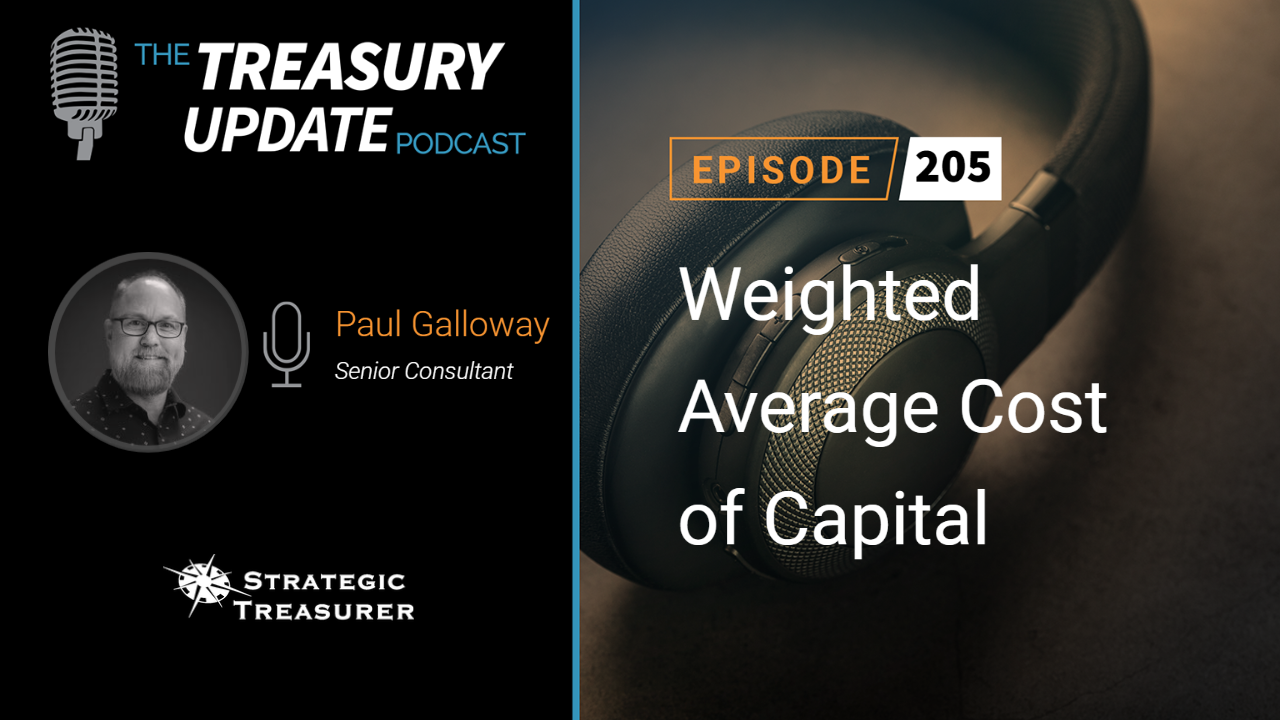
Episode 208
TIS Acquires Cashforce
This recent acquisition of Cashforce is good news for investors and for the products offered by TIS. Paul and Craig of Strategic Treasurer discuss some of their thoughts on this change.
Download our recent eBook on Payment Security & Fraud Prevention – The Principles of SECURE CLAMPS
Host:
Craig Jeffery, Strategic Treasurer


Speaker:
Paul Galloway, Strategic Treasurer


Episode Transcription - Episode #208 - TIS Acquires Cashforce
Nicki Gillispie 0:07
Welcome to The Treasury Update Podcast presented by Strategic Treasurer, your source for interesting treasury news, analysis, and insights in your car, at the gym or wherever you decide to tune in.
Paul Galloway 0:21
Welcome to The Treasury Update Podcast this is Paul Galloway and I’m joined by Craig Jeffery. Today we’re going to talk about the acquisition by TIS of Cashforce. You’ve been following and monitoring this acquisition that was recently announced. It’s something that we see from time to time in this industry. And so, help explain, you know what happened.
Craig Jeffery 0:46
We’ve long been friendly with TIS and Cashforce two strong players in some very complementary areas of the market. So TIS is a… has long been a payment hub provider that also has our treasurer aggregator, managing the collection of information, providing payment hubs services in a rapidly growing area. They also have a good visibility setup for seeing where your cash is, but also has a platform that allows you to manage your bank accounts and comply in a number of areas. So, they’ve been adding to their ecosystem for some time. Cashforce, I think many people think of that as a working capital forecasting tool, very powerful, visually oriented, the BI front end, ability to see your flows extremely well. And those two firms have partnered and collaborated for multiple years now, I believe. I think they’ve been doing some things together as preferred partners. And so, TIS acquired cash force, then so now it’s rolled up into, you know, organization ability to leverage their strengths, push them together more closely. I think there’s also underlying opportunities for more cross sales to occur. Now that there’s more features, right? You know, I pull in your bank information and see it, but you can also roll that into a forecast. Forecast is extremely important. That’s a great feature and the ability to make payments from your forecasts and from your visibility tool allows both of those products to continue the strength that they have from partnering, but to do that at a deeper level. So, a very significant change here in the market.
Paul Galloway 2:32
So, you talked about the value of the role of investors. Can you elaborate on it a little bit more in terms of what it means to the products themselves? Is this a big deal?
Craig Jeffery 2:45
We’ve seen the focus on forecasting for many organizations to be one of the number one or number two areas that companies are focused on. This has not let up. This is an area that that companies spend a lot of time if they had more time, they would spend more time on forecasting his value in return for that. And given some of the headwinds economically that are happening. That’s not going to decrease. When COVID hit people spend a lot more time modeling what will happen weather forecasts. And so what we have here is we have a vendor TIS, focused heavily on the bank side, accessing all of the data from the bank side being able to execute transactions very seamlessly and managed through that platform, merging with a company that their strength grew up out of the working capital flows the cash conversion cycle, so receivables and payables and of course, they incorporated the flow of cash, regular cash flow through bank accounts into their model, but this provides that cohesion between the two because cash is banking, cash, treasury cash, but it’s also greatly influenced and in a reciprocal way with the operating flows of organization receivable cash to deployed in the operation for inventory receivables, and return to the overall process of cash cycling through the business.
Paul Galloway 4:11
So, do you think this means that we’re going to see more consolidation in the industry or is this just a normal process?
Craig Jeffery 4:20
I think it’s a normal process. I think the idea is that there, there’s always ongoing consolidation that ebbs and flows in terms of how much happens I think that’s going to continue. The fact that new players come into the market, new treasurer providers, aggregators, these are happening over time. And so that’s, I think that’s going to continue and this happens in I don’t want to call it waves but there’s you know, as you move through different technological capabilities as technology changes, certain products might become a little older. They move through that S curve, and companies move them more towards that they’re not going to make new customers. They turn into cash cows and they’re cycling those abs will eventually say they go away at some point. The mergers, acquisitions that depends on the stage, how technology is changing. This is a big influencer on new entrants, mergers, consolidation, but I don’t see this as a start or a continuation. It’s just part of the flow of businesses is a good fit for these organizations. It’s a natural progression to from two organizations or working closely together to integrate their tech and provide very complementary services. Now they get a little closer, having some more services, being able to cross sell those two things are, I think, significant because if your selling, I can pull my balances, but I don’t have all these capabilities that perhaps Cashforce has now I can combine those two TIS. The same thing with Cashforce they filled in some of the areas that could be a gap in some competitive situations by partnering earlier with TIS. Now those are pulled together, so the ability to cross sell, build, and enhance upon the different strengths they have is a logical reason at any point in the cycle to come together.
Paul Galloway 6:15
So, what does this mean? Technically, you alluded to the change of technology, and we see some of those consolidation happening. Does that also mean that we could see as technology advances, that the cycles speed up?
Craig Jeffery 6:33
I’ll start by talking about the transaction a bit or some of the transaction. So, TIS has had a busy last year so they, most recently, they have a debt facility, put together with Kreos Capital. So, a little over 15 million USD, it was denominated in Euros, so 50 million euros, that allows them to do additional product innovation, potential acquisitions, other expansion so they’ve got dry power for some of that activity. They also have raised 40 million in equity financing not too long ago. So, they’ve been shoring up their balance sheet to be able to do this type of activity, merging and closer together. And we would expect that there would be a more close integration with the technology I mean, both of them to a large extent are more geared towards open platforms being able to connect to other players. So, we’d expect tighter integration, deeper integration there on the technical side, and then on the operations side of the organizations to sell more, to expand more, I think those are going to be significant. So, what this means is, if you’re on one of the platforms, it’s not integrated, well now you can expand or you will be able to expand more readily to other areas. You use TIS, maybe you’re going to be using forecasting from Cashforce, right, pull that in and be able to see it and use it. So, I think there’s there’ll be a lot of messaging that needs to come out of this. Their technology roadmap for pulling those things together. Those things have to be clearly defined and understood by the marketplace to really take advantage of the potential here that’s grown naturally. It’s just not out of the blue. This follows a couple of logical steps from being friendly to partnering on some things to this acquisition.
Paul Galloway 8:23
So, what’s next for TIS?
Craig Jeffery 8:26
Well, I think with the extra cash, it’s building on this activity. They’ve been quite busy with partnerships with banks. I think this is going to be occupying retention for some time. We just restate a couple of those things. One is “What is the message the market?” That needs to be clearly defined. Explain the roadmap, why this matters. I think we can talk about why it matters. But people have to capture in their minds why that matters. I can get visibility; I can run my payment. I can now perhaps leverage more fully the ability to forecast when that’s becoming more important. When the economy’s changing. I think there’s a lot of things coming together that make this a really good time for this type of tie up.
Paul Galloway 9:15
Any closing thoughts?
Craig Jeffery 9:17
I think, you know when companies find very complementary partners, that’s a very beautiful thing. You can’t necessarily build everything you want all at once, even as they’re looking at newer and newer technology which allows companies to iterate faster and develop rapidly the ability for these open systems that allow different platforms to connect together more effectively. This is how development can happen. Other companies coming together in a tighter way and then leveraging a broader a larger set of resources that exist. So, I think that’s exciting for both the TIS team and the Cashforce team. I think it provides more opportunities, the more competition there is in the space of the whole cash conversion cycle. I think the stronger the market will become, and we need efficiency continually solid growth solid capabilities with tech, with the ability to do more, do things more significantly. And this holds a lot of problems from it.
OUTRO 10:20
You’ve reached the end of another episode of The Treasury Update podcast. Be sure to follow Strategic Treasurer on LinkedIn, just search for Strategic Treasurer. This podcast is provided for informational purposes only, and statements made by Strategic Treasurer LLC on this podcast, are not intended as legal, business, consulting, or tax advice. For more information, visit and bookmark strategictreasurer.com
Subscribe to the Treasury Update Podcast on your favorite app!
Related Resources
Researching new treasury and finance technology can be overwhelming. Strategic Treasurer has stepped in to help. Explore our definitive guide to the treasury technology landscape and discover detailed, data-based coverage of each area.
Weighted Average Cost of Capital
A firm’s debt and equity are important components when investors are watching. What is the cost to fund your operations? What costs are required to make investments or develop new products? In this podcast, Craig Jeffery and Paul Galloway of Strategic Treasurer discuss your WACC or Weighted Average Cost of Capital.








